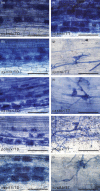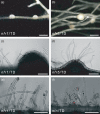A dominant function of CCaMK in intracellular accommodation of bacterial and fungal endosymbionts
- PMID: 20409002
- PMCID: PMC2916219
- DOI: 10.1111/j.1365-313X.2010.04228.x
A dominant function of CCaMK in intracellular accommodation of bacterial and fungal endosymbionts
Abstract
In legumes, Ca(2+)/calmodulin-dependent protein kinase (CCaMK) is a component of the common symbiosis genes that are required for both root nodule (RN) and arbuscular mycorrhiza (AM) symbioses and is thought to be a decoder of Ca(2+) spiking, one of the earliest cellular responses to microbial signals. A gain-of-function mutation of CCaMK has been shown to induce spontaneous nodulation without rhizobia, but the significance of CCaMK activation in bacterial and/or fungal infection processes is not fully understood. Here we show that a gain-of-function CCaMK(T265D) suppresses loss-of-function mutations of common symbiosis genes required for the generation of Ca(2+) spiking, not only for nodule organogenesis but also for successful infection of rhizobia and AM fungi, demonstrating that the common symbiosis genes upstream of Ca(2+) spiking are required solely to activate CCaMK. In RN symbiosis, however, CCaMK(T265D) induced nodule organogenesis, but not rhizobial infection, on Nod factor receptor (NFRs) mutants. We propose a model of symbiotic signaling in host legume plants, in which CCaMK plays a key role in the coordinated induction of infection thread formation and nodule organogenesis.
Figures





Similar articles
-
Rhizobial and fungal symbioses show different requirements for calmodulin binding to calcium calmodulin-dependent protein kinase in Lotus japonicus.Plant Cell. 2012 Jan;24(1):304-21. doi: 10.1105/tpc.111.092197. Epub 2012 Jan 17. Plant Cell. 2012. PMID: 22253228 Free PMC article.
-
Spontaneous symbiotic reprogramming of plant roots triggered by receptor-like kinases.Elife. 2014 Nov 25;3:e03891. doi: 10.7554/eLife.03891. Elife. 2014. PMID: 25422918 Free PMC article.
-
Nuclear-localized and deregulated calcium- and calmodulin-dependent protein kinase activates rhizobial and mycorrhizal responses in Lotus japonicus.Plant Cell. 2012 Feb;24(2):810-22. doi: 10.1105/tpc.111.091827. Epub 2012 Feb 14. Plant Cell. 2012. PMID: 22337918 Free PMC article.
-
Activation of calcium- and calmodulin-dependent protein kinase (CCaMK), the central regulator of plant root endosymbiosis.Curr Opin Plant Biol. 2012 Aug;15(4):444-53. doi: 10.1016/j.pbi.2012.04.002. Epub 2012 Jun 22. Curr Opin Plant Biol. 2012. PMID: 22727503 Review.
-
Regulation of signal transduction and bacterial infection during root nodule symbiosis.Curr Opin Plant Biol. 2011 Aug;14(4):458-67. doi: 10.1016/j.pbi.2011.03.016. Epub 2011 Apr 12. Curr Opin Plant Biol. 2011. PMID: 21489860 Review.
Cited by
-
The independent acquisition of plant root nitrogen-fixing symbiosis in Fabids recruited the same genetic pathway for nodule organogenesis.PLoS One. 2013 May 31;8(5):e64515. doi: 10.1371/journal.pone.0064515. Print 2013. PLoS One. 2013. PMID: 23741336 Free PMC article.
-
Function and evolution of a Lotus japonicus AP2/ERF family transcription factor that is required for development of infection threads.DNA Res. 2017 Apr 1;24(2):193-203. doi: 10.1093/dnares/dsw052. DNA Res. 2017. PMID: 28028038 Free PMC article.
-
Host-specific Nod-factors associated with Medicago truncatula nodule infection differentially induce calcium influx and calcium spiking in root hairs.New Phytol. 2013 Nov;200(3):656-662. doi: 10.1111/nph.12475. Epub 2013 Sep 10. New Phytol. 2013. PMID: 24015832 Free PMC article.
-
Rhizobial and fungal symbioses show different requirements for calmodulin binding to calcium calmodulin-dependent protein kinase in Lotus japonicus.Plant Cell. 2012 Jan;24(1):304-21. doi: 10.1105/tpc.111.092197. Epub 2012 Jan 17. Plant Cell. 2012. PMID: 22253228 Free PMC article.
-
Calcium-dependent protein kinases from Arabidopsis show substrate specificity differences in an analysis of 103 substrates.Front Plant Sci. 2011 Aug 30;2:36. doi: 10.3389/fpls.2011.00036. eCollection 2011. Front Plant Sci. 2011. PMID: 22645532 Free PMC article.
References
-
- Amor BB, Shaw SL, Oldroyd GE, Maillet F, Penmetsa RV, Cook D, Long SR, Dénarié J, Gough C. The NFP locus of Medicago truncatula controls an early step of Nod factor signal transduction upstream of a rapid calcium flux and root hair deformation. Plant J. 2003;34:495–506. - PubMed
-
- Ané JM, Kiss GB, Riely BK, et al. Medicago truncatula DMI1 required for bacterial and fungal symbioses in legumes. Science. 2004;303:1364–1367. - PubMed
-
- Ardourel M, Demont N, Debellé F, Maillet F, de Billy F, Promé JC, Dénarié J, Truchet G. Rhizobium meliloti lipooligosaccharide nodulation factors, different structural requirements for bacterial entry into target root hair cells and induction of plant symbiotic developmental responses. Plant Cell. 1994;6:1357–1374. - PMC - PubMed
-
- Banba M, Gutjahr C, Miyao A, Hirochika H, Paszkowski U, Kouchi H, Imaizumi-Anraku H. Divergence of evolutionary ways among common sym genes: CASTOR and CCaMK show functional conservation between two symbiosis systems and constitute the root of a common signaling pathway. Plant Cell Physiol. 2008;49:1659–1671. - PubMed
Publication types
MeSH terms
Substances
LinkOut - more resources
Full Text Sources
Other Literature Sources
Miscellaneous

